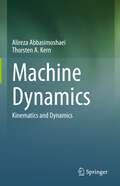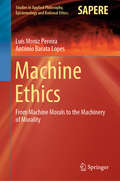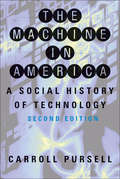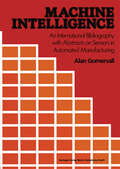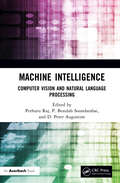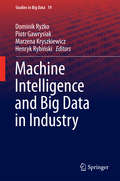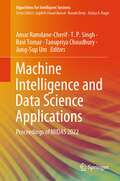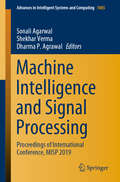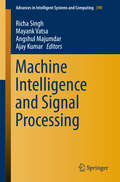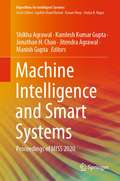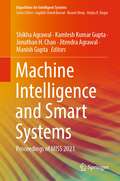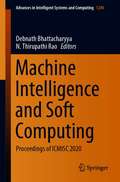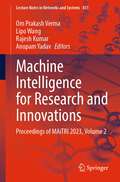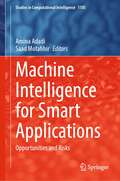- Table View
- List View
Machine Dynamics: Kinematics and Dynamics
by Alireza Abbasimoshaei Thorsten A. KernIn this book, we aim to give a thorough introduction to machine dynamics. It covers the theoretical basis of dynamics, modelling, mechanical design, practical applications, kinematics and kinetics, principles of mechanics, equations of motion for multibody systems, applications to mechanisms, vehicle dynamics, and static and dynamic balancing. It covers a complete range of mechanisms and concepts, from the determination of degrees of freedom to the design of complex cams. This progression is explained at a reasonable pace so that by the end the reader is able to design and analyze mechanical systems. Throughout the book, we also try to introduce conceptual examples and exercises to make the text more practical and understandable for the reader and also useful as a reference for lectures in universities. In addition, most books in this field are too voluminous and therefore are not suitable as a reference for a lecture. In this book, we have reduced the unnecessary theory part and put more emphasis on practical examples. Moreover, it is written in such a way that it will guide the readers even if they have forgotten the dynamics and basic concept and provide enough information. So this book can be used as a self-study book.
Machine Elements: Life and Design
by Boris M. Klebanov David M. Barlam Frederic E. NystromFocusing on how a machine "feels" and behaves while operating, Machine Elements: Life and Design seeks to impart both intellectual and emotional comprehension regarding the "life" of a machine. It presents a detailed description of how machines elements function, seeking to form a sympathetic attitude toward the machine and to ensure its wellbeing
Machine Ethics: From Machine Morals to the Machinery of Morality (Studies in Applied Philosophy, Epistemology and Rational Ethics #53)
by Luís Moniz Pereira António Barata LopesThis book offers the first systematic guide to machine ethics, bridging between computer science, social sciences and philosophy. Based on a dialogue between an AI scientist and a novelist philosopher, the book discusses important findings on which moral values machines can be taught and how. In turn, it investigates what kind of artificial intelligence (AI) people do actually want. What are the main consequences of the integration of AI in people’s every-day life? In order to co-exist and collaborate with humans, machines need morality, but which moral values should we teach them? Moreover, how can we implement benevolent AI? These are just some of the questions carefully examined in the book, which offers a comprehensive account of ethical issues concerning AI, on the one hand, and a timely snapshot of the power and potential benefits of this technology on the other. Starting with an introduction to common-sense ethical principles, the book then guides the reader, helping them develop and understand more complex ethical concerns and placing them in a larger, technological context. The book makes these topics accessible to a non-expert audience, while also offering alternative reading pathways to inspire more specialized readers.
Machine Ethics and Robot Ethics
by Wendell Wallach Peter AsaroOnce the stuff of science fiction, recent progress in artificial intelligence, robotics, and machine learning means that these rapidly advancing technologies are finally coming into widespread use within everyday life. Such rapid development in these areas also brings with it a host of social, political and legal issues, as well as a rise in public concern and academic interest in the ethical challenges these new technologies pose. This volume is a collection of scholarly work from leading figures in the development of both robot ethics and machine ethics; it includes essays of historical significance which have become foundational for research in these two new areas of study, as well as important recent articles. The research articles selected focus on the control and governance of computational systems; the exploration of ethical and moral theories using software and robots as laboratories or simulations; inquiry into the necessary requirements for moral agency and the basis and boundaries of rights; and questions of how best to design systems that are both useful and morally sound. Collectively the articles ask what the practical ethical and legal issues, arising from the development of robots, will be over the next twenty years and how best to address these future considerations.
Machine Ethics and Robot Ethics
by Wendell Wallach and Peter AsaroOnce the stuff of science fiction, recent progress in artificial intelligence, robotics, and machine learning means that these rapidly advancing technologies are finally coming into widespread use within everyday life. Such rapid development in these areas also brings with it a host of social, political and legal issues, as well as a rise in public concern and academic interest in the ethical challenges these new technologies pose. This volume is a collection of scholarly work from leading figures in the development of both robot ethics and machine ethics; it includes essays of historical significance which have become foundational for research in these two new areas of study, as well as important recent articles. The research articles selected focus on the control and governance of computational systems; the exploration of ethical and moral theories using software and robots as laboratories or simulations; inquiry into the necessary requirements for moral agency and the basis and boundaries of rights; and questions of how best to design systems that are both useful and morally sound. Collectively the articles ask what the practical ethical and legal issues, arising from the development of robots, will be over the next twenty years and how best to address these future considerations.
The Machine in America: A Social History of Technology
by Carroll PursellFrom the medieval farm implements used by the first colonists to the invisible links of the Internet, the history of technology in America is a history of society as well. Arguing that "the tools and processes we use are a part of our lives, not simply instruments of our purpose," historian Carroll Pursell analyzes technology's impact on the lives of women and men, on their work, politics, and social relationships—and how, in turn, people influence technological development.Pursell shows how both the idea of progress and the mechanical means to harness the forces of nature developed and changed as they were brought from the Old World to the New. He describes the ways in which American industrial and agricultural technology began to take on a distinctive shape as it adapted and extended the technical base of the industrial revolution. He discusses the innovation of an American system of manufactures and the mechanization of agriculture; new systems of mining, lumbering, and farming, which helped conquer and define the West; and the technologies that shaped the rise of cities. In the second edition of The Machine in America, Pursell brings this classic history up to date with a revised chapter on war technology and new discussions on information technology, globalization, and the environment.
Machine Intelligence: An International Bibliography with Abstracts of Sensors in Automated Manufacturing
by A. GomersallIn 1981 Robotics Bibliography was published containing over 1,800 references on industrial robot research and development, culled from the scientific literature over the previous 12 years. It was felt that sensors for use with industrial robots merited a section and accordingly just over 200 papers were included. It is a sign of the increased research into sensors in production engineering that this bibliography on both the contact and non-contact forms has appeared less than three years after that first comprehensive collection of references appeared. In a reviell''; in 1975 Professor Warnecke of IPA, Stuttgart drew attention to the lack of sensors for touch and vision. Since then research workers in various companies, universities and national laboratories in the USA, the UK, Italy, Germany and Japan have concentrated on improving sensor capabilities, particularly utilising vision, artificial intelligence and pattern recognition principles. As a result many research projects are on the brink of commercial exploitation and development. This biblio graphy brings together the documentation on that research and development, highlighting the advances made in vision systems, but not neglecting the development of tactile sensors of various types. No bibliography can ever be comprehensive, but significant contributions from research workers and production engineers from the major industrialised countries over the last 12 years have been included.
Machine Intelligence: Computer Vision and Natural Language Processing
by Pethuru Raj Peter Augustine P. Beaulah SoundarabaiMachines are being systematically empowered to be interactive and intelligent in their operations, offerings. and outputs. There are pioneering Artificial Intelligence (AI) technologies and tools. Machine and Deep Learning (ML/DL) algorithms, along with their enabling frameworks, libraries, and specialized accelerators, find particularly useful applications in computer and machine vision, human machine interfaces (HMIs), and intelligent machines. Machines that can see and perceive can bring forth deeper and decisive acceleration, automation, and augmentation capabilities to businesses as well as people in their everyday assignments. Machine vision is becoming a reality because of advancements in the computer vision and device instrumentation spaces. Machines are increasingly software-defined. That is, vision-enabling software and hardware modules are being embedded in new-generation machines to be self-, surroundings, and situation-aware.Machine Intelligence: Computer Vision and Natural Language Processing emphasizes computer vision and natural language processing as drivers of advances in machine intelligence. The book examines these technologies from the algorithmic level to the applications level. It also examines the integrative technologies enabling intelligent applications in business and industry.Features: Motion images object detection over voice using deep learning algorithms Ubiquitous computing and augmented reality in HCI Learning and reasoning in Artificial Intelligence Economic sustainability, mindfulness, and diversity in the age of artificial intelligence and machine learning Streaming analytics for healthcare and retail domains Covering established and emerging technologies in machine vision, the book focuses on recent and novel applications and discusses state-of-the-art technologies and tools.
Machine Intelligence: Computer Vision and Natural Language Processing
by Pethuru Raj P. Beaulah Soundarabai D. Peter AugustineMachines are being systematically empowered to be interactive and intelligent in their operations, offerings. and outputs. There are pioneering Artificial Intelligence (AI) technologies and tools. Machine and Deep Learning (ML/DL) algorithms, along with their enabling frameworks, libraries, and specialized accelerators, find particularly useful applications in computer and machine vision, human machine interfaces (HMIs), and intelligent machines. Machines that can see and perceive can bring forth deeper and decisive acceleration, automation, and augmentation capabilities to businesses as well as people in their everyday assignments. Machine vision is becoming a reality because of advancements in the computer vision and device instrumentation spaces. Machines are increasingly software-defined. That is, vision-enabling software and hardware modules are being embedded in new-generation machines to be self-, surroundings, and situation-aware.Machine Intelligence: Computer Vision and Natural Language Processing emphasizes computer vision and natural language processing as drivers of advances in machine intelligence. The book examines these technologies from the algorithmic level to the applications level. It also examines the integrative technologies enabling intelligent applications in business and industry.Features: Motion images object detection over voice using deep learning algorithms Ubiquitous computing and augmented reality in HCI Learning and reasoning in Artificial Intelligence Economic sustainability, mindfulness, and diversity in the age of artificial intelligence and machine learning Streaming analytics for healthcare and retail domains Covering established and emerging technologies in machine vision, the book focuses on recent and novel applications and discusses state-of-the-art technologies and tools.
Machine Intelligence and Big Data Analytics for Cybersecurity Applications (Studies in Computational Intelligence #919)
by Yassine Maleh Mohammad Shojafar Mamoun Alazab Youssef BaddiThis book presents the latest advances in machine intelligence and big data analytics to improve early warning of cyber-attacks, for cybersecurity intrusion detection and monitoring, and malware analysis. Cyber-attacks have posed real and wide-ranging threats for the information society. Detecting cyber-attacks becomes a challenge, not only because of the sophistication of attacks but also because of the large scale and complex nature of today’s IT infrastructures. It discusses novel trends and achievements in machine intelligence and their role in the development of secure systems and identifies open and future research issues related to the application of machine intelligence in the cybersecurity field. Bridging an important gap between machine intelligence, big data, and cybersecurity communities, it aspires to provide a relevant reference for students, researchers, engineers, and professionals working in this area or those interested in grasping its diverse facets and exploring the latest advances on machine intelligence and big data analytics for cybersecurity applications.
Machine Intelligence and Big Data in Industry (Studies in Big Data #19)
by Dominik Ryżko Piotr Gawrysiak Marzena Kryszkiewicz Henryk RybińskiThis book presents valuable contributions devoted to practical applications of Machine Intelligence and Big Data in various branches of the industry. All the contributions are extended versions of presentations delivered at the Industrial Session the 6th International Conference on Pattern Recognition and Machine Intelligence (PREMI 2015) held in Warsaw, Poland at June 30- July 3, 2015, which passed through a rigorous reviewing process. The contributions address real world problems and show innovative solutions used to solve them. This volume will serve as a bridge between researchers and practitioners, as well as between different industry branches, which can benefit from sharing ideas and results.
Machine Intelligence and Data Analytics for Sustainable Future Smart Cities (Studies in Computational Intelligence #971)
by Uttam Ghosh Yassine Maleh Mamoun Alazab Al-Sakib Khan PathanThis book presents the latest advances in computational intelligence and data analytics for sustainable future smart cities. It focuses on computational intelligence and data analytics to bring together the smart city and sustainable city endeavors. It also discusses new models, practical solutions and technological advances related to the development and the transformation of cities through machine intelligence and big data models and techniques. This book is helpful for students and researchers as well as practitioners.
Machine Intelligence and Data Science Applications: Proceedings of MIDAS 2022 (Algorithms for Intelligent Systems)
by Amar Ramdane-Cherif T. P. Singh Ravi Tomar Tanupriya Choudhury Jung-Sup UmThis book is a compilation of peer-reviewed papers presented at the International Conference on Machine Intelligence and Data Science Applications (MIDAS 2022), held on October 28 and 29, 2022, at the University of Versailles—Paris-Saclay, France. The book covers applications in various fields like data science, machine intelligence, image processing, natural language processing, computer vision, sentiment analysis, and speech and gesture analysis. It also includes interdisciplinary applications like legal, healthcare, smart society, cyber-physical system, and smart agriculture. The book is a good reference for computer science engineers, lecturers/researchers in the machine intelligence discipline, and engineering graduates.
Machine Intelligence and Data Science Applications: Proceedings of MIDAS 2021 (Lecture Notes on Data Engineering and Communications Technologies #132)
by Vaclav Skala T. P. Singh Tanupriya Choudhury Ravi Tomar Md. Abul BasharThis book is a compilation of peer reviewed papers presented at International Conference on Machine Intelligence and Data Science Applications (MIDAS 2021), held in Comilla University, Cumilla, Bangladesh during 26 – 27 December 2021. The book covers applications in various fields like image processing, natural language processing, computer vision, sentiment analysis, speech and gesture analysis, etc. It also includes interdisciplinary applications like legal, healthcare, smart society, cyber physical system and smart agriculture, etc. The book is a good reference for computer science engineers, lecturers/researchers in machine intelligence discipline and engineering graduates.
Machine Intelligence and Signal Analysis (Advances in Intelligent Systems and Computing #748)
by M. Tanveer Ram Bilas PachoriThe book covers the most recent developments in machine learning, signal analysis, and their applications. It covers the topics of machine intelligence such as: deep learning, soft computing approaches, support vector machines (SVMs), least square SVMs (LSSVMs) and their variants; and covers the topics of signal analysis such as: biomedical signals including electroencephalogram (EEG), magnetoencephalography (MEG), electrocardiogram (ECG) and electromyogram (EMG) as well as other signals such as speech signals, communication signals, vibration signals, image, and video. Further, it analyzes normal and abnormal categories of real-world signals, for example normal and epileptic EEG signals using numerous classification techniques. The book is envisioned for researchers and graduate students in Computer Science and Engineering, Electrical Engineering, Applied Mathematics, and Biomedical Signal Processing.
Machine Intelligence and Signal Processing: Proceedings of International Conference, MISP 2019 (Advances in Intelligent Systems and Computing #1085)
by Sonali Agarwal Shekhar Verma Dharma P. AgrawalThis book features selected high-quality research papers presented at the International Conference on Machine Intelligence and Signal Processing (MISP 2019), held at the Indian Institute of Technology, Allahabad, India, on September 7–10, 2019. The book covers the latest advances in the fields of machine learning, big data analytics, signal processing, computational learning theory, and their real-time applications. The topics covered include support vector machines (SVM) and variants like least-squares SVM (LS-SVM) and twin SVM (TWSVM), extreme learning machine (ELM), artificial neural network (ANN), and other areas in machine learning. Further, it discusses the real-time challenges involved in processing big data and adapting the algorithms dynamically to improve the computational efficiency. Lastly, it describes recent developments in processing signals, for instance, signals generated from IoT devices, smart systems, speech, and videos and addresses biomedical signal processing: electrocardiogram (ECG) and electroencephalogram (EEG).
Machine Intelligence and Signal Processing (Advances in Intelligent Systems and Computing #390)
by Richa Singh Mayank Vatsa Angshul Majumdar Ajay KumarThis book comprises chapters on key problems in machine learning and signal processing arenas. The contents of the book are a result of a 2014 Workshop on Machine Intelligence and Signal Processing held at the Indraprastha Institute of Information Technology. Traditionally, signal processing and machine learning were considered to be separate areas of research. However in recent times the two communities are getting closer. In a very abstract fashion, signal processing is the study of operator design. The contributions of signal processing had been to device operators for restoration, compression, etc. Applied Mathematicians were more interested in operator analysis. Nowadays signal processing research is gravitating towards operator learning – instead of designing operators based on heuristics (for example wavelets), the trend is to learn these operators (for example dictionary learning). And thus, the gap between signal processing and machine learning is fast converging. The 2014 Workshop on Machine Intelligence and Signal Processing was one of the few unique events that are focused on the convergence of the two fields. The book is comprised of chapters based on the top presentations at the workshop. This book has three chapters on various topics of biometrics – two are on face detection and one on iris recognition; all from top researchers in their field. There are four chapters on different biomedical signal / image processing problems. Two of these are on retinal vessel classification and extraction; one on biomedical signal acquisition and the fourth one on region detection. There are three chapters on data analysis – a topic gaining immense popularity in industry and academia. One of these shows a novel use of compressed sensing in missing sales data interpolation. Another chapter is on spam detection and the third one is on simple one-shot movie rating prediction. Four other chapters cover various cutting edge miscellaneous topics on character recognition, software effort prediction, speech recognition and non-linear sparse recovery. The contents of this book will prove useful to researchers, professionals and students in the domains of machine learning and signal processing.
Machine Intelligence and Smart Systems: Proceedings of MISS 2020 (Algorithms for Intelligent Systems)
by Jitendra Agrawal Jonathan H. Chan Manish Gupta Shikha Agrawal Kamlesh Kumar GuptaThis book is a collection of peer-reviewed best selected research papers presented at the First International Conference on Machine Intelligence and Smart Systems 2020 (MISS 2020), organized during September 24–25, 2020, in Gwalior, India. The book presents new advances and research results in the fields of machine intelligence, artificial intelligence and smart systems. It includes main paradigms of machine intelligence algorithms, namely (1) neural networks, (2) evolutionary computation, (3) swarm intelligence, (4) fuzzy systems and (5) immunological computation.
Machine Intelligence and Smart Systems: Proceedings of MISS 2021 (Algorithms for Intelligent Systems)
by Shikha Agrawal Kamlesh Kumar Gupta Jonathan H. Chan Jitendra Agrawal Manish GuptaThis book is a collection of peer-reviewed best selected research papers presented at the Second International Conference on Machine Intelligence and Smart Systems (MISS 2021), organized during September 24–25, 2021, in Gwalior, India. The book presents new advances and research results in the fields of machine intelligence, artificial intelligence and smart systems. It includes main paradigms of machine intelligence algorithms, namely (1) neural networks, (2) evolutionary computation, (3) swarm intelligence, (4) fuzzy systems and (5) immunological computation. Scientists, engineers, academicians, technology developers, researchers, students and government officials will find this book useful in handling their complicated real-world issues by using machine intelligence methodologies.
Machine Intelligence and Soft Computing: Proceedings of ICMISC 2020 (Advances in Intelligent Systems and Computing #1280)
by Debnath Bhattacharyya N. Thirupathi RaoThis book gathers selected papers presented at the International Conference on Machine Intelligence and Soft Computing (ICMISC 2020), held jointly by Vignan’s Institute of Information Technology, Visakhapatnam, India and VFSTR Deemed to be University, Guntur, AP, India during 03-04 September 2020. Topics covered in the book include the artificial neural networks and fuzzy logic, cloud computing, evolutionary algorithms and computation, machine learning, metaheuristics and swarm intelligence, neuro-fuzzy system, soft computing and decision support systems, soft computing applications in actuarial science, soft computing for database deadlock resolution, soft computing methods in engineering, and support vector machine.
Machine Intelligence and Soft Computing: Proceedings of ICMISC 2021 (Advances in Intelligent Systems and Computing #1419)
by Philippe Fournier-Viger Debnath Bhattacharyya Sanjoy Kumar SahaThis book gathers selected papers presented at the International Conference on Machine Intelligence and Soft Computing (ICMISC 2021), organized by Koneru Lakshmaiah Education Foundation, Guntur, Andhra Pradesh, India during 22 – 24 September 2021. The topics covered in the book include the artificial neural networks and fuzzy logic, cloud computing, evolutionary algorithms and computation, machine learning, metaheuristics and swarm intelligence, neuro-fuzzy system, soft computing and decision support systems, soft computing applications in actuarial science, soft computing for database deadlock resolution, soft computing methods in engineering, and support vector machine.
Machine Intelligence, Big Data Analytics, and IoT in Image Processing: Practical Applications
by Ashok Kumar Megha Bhushan José A. Galindo Lalit Garg Yu-Chen HuMACHINE INTELLIGENCE, BIG DATA ANALYTICS, AND IoT IN IMAGE PROCESSING Discusses both theoretical and practical aspects of how to harness advanced technologies to develop practical applications such as drone-based surveillance, smart transportation, healthcare, farming solutions, and robotics used in automation. The concepts of machine intelligence, big data analytics, and the Internet of Things (IoT) continue to improve our lives through various cutting-edge applications such as disease detection in real-time, crop yield prediction, smart parking, and so forth. The transformative effects of these technologies are life-changing because they play an important role in demystifying smart healthcare, plant pathology, and smart city/village planning, design and development. This book presents a cross-disciplinary perspective on the practical applications of machine intelligence, big data analytics, and IoT by compiling cutting-edge research and insights from researchers, academicians, and practitioners worldwide. It identifies and discusses various advanced technologies, such as artificial intelligence, machine learning, IoT, image processing, network security, cloud computing, and sensors, to provide effective solutions to the lifestyle challenges faced by humankind. Machine Intelligence, Big Data Analytics, and IoT in Image Processing is a significant addition to the body of knowledge on practical applications emerging from machine intelligence, big data analytics, and IoT. The chapters deal with specific areas of applications of these technologies. This deliberate choice of covering a diversity of fields was to emphasize the applications of these technologies in almost every contemporary aspect of real life to assist working in different sectors by understanding and exploiting the strategic opportunities offered by these technologies. Audience The book will be of interest to a range of researchers and scientists in artificial intelligence who work on practical applications using machine learning, big data analytics, natural language processing, pattern recognition, and IoT by analyzing images. Software developers, industry specialists, and policymakers in medicine, agriculture, smart cities development, transportation, etc. will find this book exceedingly useful.
Machine Intelligence, Big Data Analytics, and IoT in Image Processing: Practical Applications
by Ashok Kumar Megha Bhushan Jose Galindo Lalit Garg Yu-Chen HuMACHINE INTELLIGENCE, BIG DATA ANALYTICS, AND IoT IN IMAGE PROCESSING Discusses both theoretical and practical aspects of how to harness advanced technologies to develop practical applications such as drone-based surveillance, smart transportation, healthcare, farming solutions, and robotics used in automation. The concepts of machine intelligence, big data analytics, and the Internet of Things (IoT) continue to improve our lives through various cutting-edge applications such as disease detection in real-time, crop yield prediction, smart parking, and so forth. The transformative effects of these technologies are life-changing because they play an important role in demystifying smart healthcare, plant pathology, and smart city/village planning, design and development. This book presents a cross-disciplinary perspective on the practical applications of machine intelligence, big data analytics, and IoT by compiling cutting-edge research and insights from researchers, academicians, and practitioners worldwide. It identifies and discusses various advanced technologies, such as artificial intelligence, machine learning, IoT, image processing, network security, cloud computing, and sensors, to provide effective solutions to the lifestyle challenges faced by humankind. Machine Intelligence, Big Data Analytics, and IoT in Image Processing is a significant addition to the body of knowledge on practical applications emerging from machine intelligence, big data analytics, and IoT. The chapters deal with specific areas of applications of these technologies. This deliberate choice of covering a diversity of fields was to emphasize the applications of these technologies in almost every contemporary aspect of real life to assist working in different sectors by understanding and exploiting the strategic opportunities offered by these technologies. Audience The book will be of interest to a range of researchers and scientists in artificial intelligence who work on practical applications using machine learning, big data analytics, natural language processing, pattern recognition, and IoT by analyzing images. Software developers, industry specialists, and policymakers in medicine, agriculture, smart cities development, transportation, etc. will find this book exceedingly useful.
Machine Intelligence for Research and Innovations: Proceedings of MAiTRI 2023, Volume 2 (Lecture Notes in Networks and Systems #831)
by Om Prakash Verma Lipo Wang Rajesh Kumar Anupam YadavThe book is a collection of high-quality peer-reviewed research papers presented in the First International Conference on Machine Intelligence for Research and Innovations (MAiTRI 2023 Summit), held at Dr B R Ambedkar National Institute of Technology Jalandhar, Punjab, India during 1 – 3 September 2023. This book focuses on recent advancement in the theory and realization of machine intelligence (MI) and their tools and growing applications such as machine learning, deep learning, quantum machine learning, real-time computer vision, pattern recognition, natural language processing, statistical modelling, autonomous vehicles, human interfaces, computational intelligence, and robotics.
Machine Intelligence for Smart Applications: Opportunities and Risks (Studies in Computational Intelligence #1105)
by Amina Adadi Saad MotahhirThis book provides insights into recent advances in Machine Intelligence (MI) and related technologies, identifies risks and challenges that are, or could be, slowing down overall MI mainstream adoption and innovation efforts, and discusses potential solutions to address these limitations. All these aspects are explored through the lens of smart applications. The book navigates the landscape of the most recent, prominent, and impactful MI smart applications. The broad set of smart applications for MI is organized into four themes covering all areas of the economy and social life, namely (i) Smart Environment, (ii) Smart Social Living, (iii) Smart Business and Manufacturing, and (iv) Smart Government. The book examines not only present smart applications but also takes a look at how MI may potentially be applied in the future. This book is aimed at researchers and postgraduate students in applied artificial intelligence and allied technologies. The book is also valuable for practitioners, and it serves as a bridge between researchers and practitioners. It also helps connect researchers interested in MI technologies who come from different social and business disciplines and who can benefit from sharing ideas and results.
